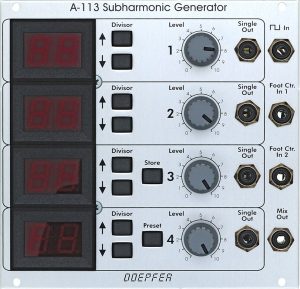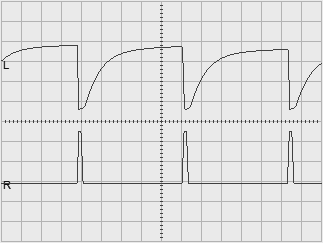The Subharmonic Oscillator is a very unusual module that originated in Doepfer’s Trautonium project. Doepfer had implemented the necessary components of a Trautonium (a historical forerunner of today’s analog synthesizer by Friedrich Trautwein, 1888-1956) within the A-100 system.
Unlike most other frequency dividers that output square wave signals, the A-113 produces sawtooth signals whose frequency is one integer divider below a “master” oscillator. Incidentally, these are by no means “mathematically exact” sawtooth signals, but somewhat crooked waveforms that are difficult to achieve with other oscillators.
The module has 4 built-in frequency dividers, the signals generated can either be tapped individually or mixed to form a sum signal. The compilation of the four division ratios for the frequency dividers (e.g. 1/3, 1/5, 1/7 and 1/11) is referred to as a “mixture”.
Four different “mixtures” (e.g. 1/2, 1/3, 1/8 and 1/16 as the first mix, 1/2, 1/3, 1/4, 1/5 as the second mix, 1/2, 1/4, 1/8 and 1/16 as the third mixture and four times 1/2 as the fourth mixture) can be saved as a preset and called up via gate signals. In the original Trautonium, these gate signals were generated with foot switches, in the modular system you can let your imagination roam a little further. A total of 50 such presets can be saved.
The idea behind the use of “subharmonics” is to supplement the harmonic overtone series (as it occurs naturally in wind instruments, for example) downwards. While the overtone series consists of double, triple, 4 times, 5 times, etc. the frequency of the fundamental, the subharmonics are 1/2, 1/3, 1/4, 1/5, etc. of the frequency of the fundamental. Interestingly, the tones of the major chord can be derived from the first overtone series, while the tones of the minor chord (with the starting note in the fifth) can be generated from the subharmonics invented for it.
User interface
Inputs:
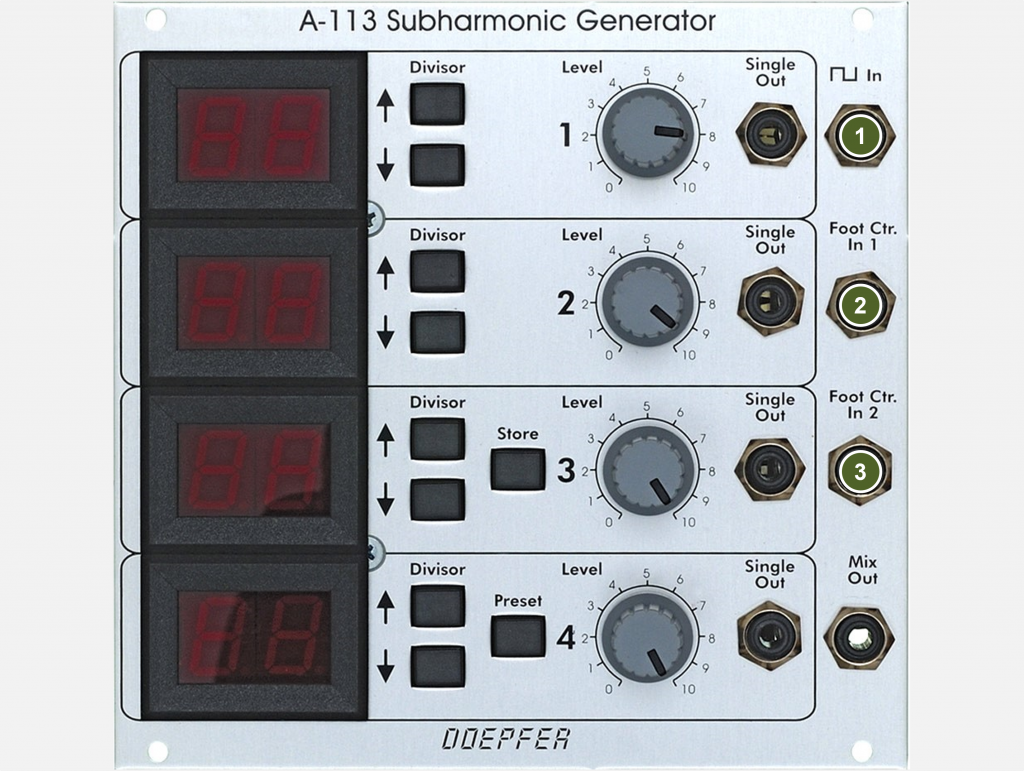
- In: Audio input for a square wave signal.
- Foot Ctr. In 1: Input for a gate signal (e.g. from a foot switch) to switch the “mixture”, together with the “Foot Ctr. In 2” input, four different mixes can be stored and recalled. When the gate signal is present, a decimal point is shown after the first digit in the displays.
- Foot Ctr. In 2: Input for a gate signal (e.g. from a foot switch) to switch the “mixture”. When the gate signal is present, a decimal point is shown after the second digit in the displays. There are 4 mixtures: “XY”, “X.Y”, “XY.” and “XY.” (with X and Y as the two digits of the divider factor). For example, if both gate signals are present and you change the division factor of the first frequency divider, this factor is saved and can be called up again by applying both gate signals.
Outputs:
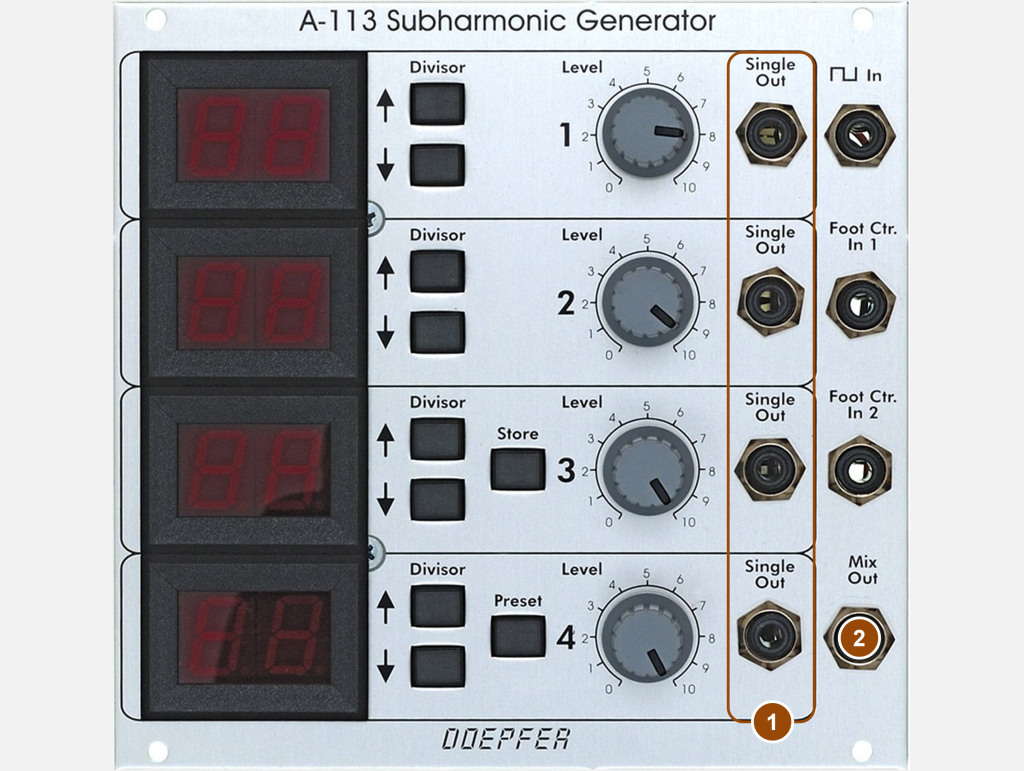
- Single Out (separate for each frequency divider): Individual outputs for the sawtooth signals from the frequency dividers.
- Mix Out: Audio output for mixing the four sawtooth signals from the frequency dividers.
Controls:
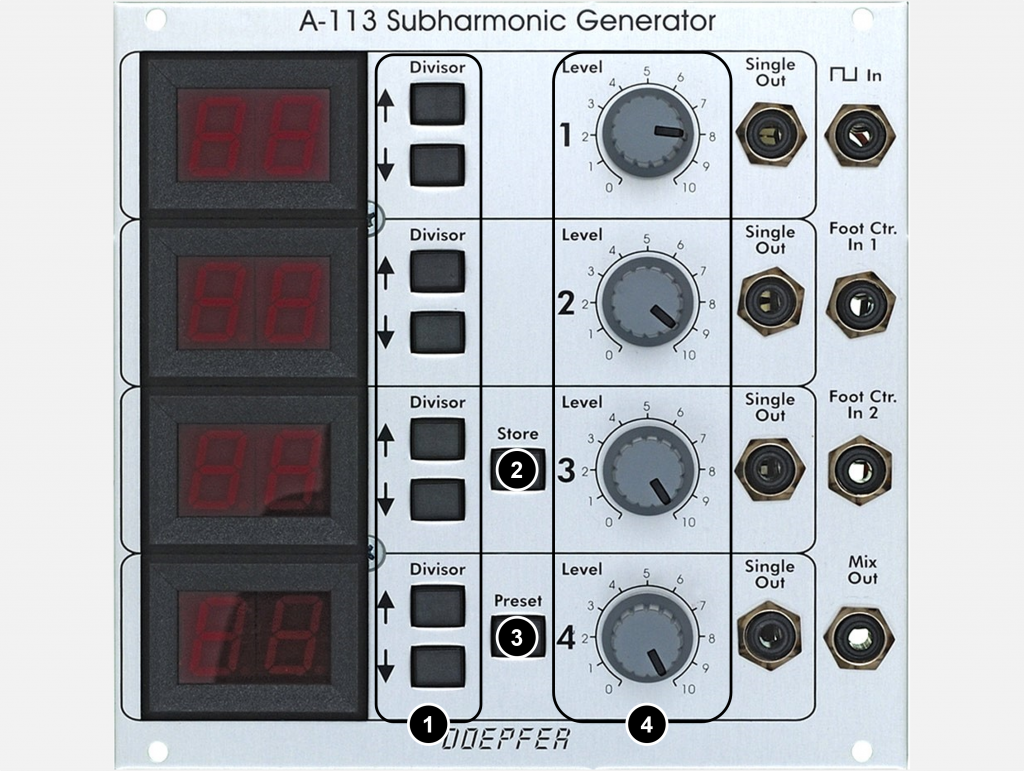
- Divisor (separate for each of the 4 frequency dividers): Buttons for setting the divider in integer steps.
- Store button: For storing a preset (with 4 switchable “mixtures”). To do this, hold down the “Preset” button, use the two “Divisor” buttons of the 4th frequency divider to select the desired memory location and then press the “Store” button (keep the “Preset” button pressed).
- Preset button: To select a saved preset. To do this, hold down the “Preset” button and select the desired preset with the “Divisor” buttons of the 4th frequency divider. When holding “Preset”, the 3rd display will show “Pr” and the 4th display will show the number of the preset.
- Level: Control for the volume of the respective frequency divider output.
The four displays are used to show the divider ratios (separately for each frequency divider). Dividers from 1 to 1/24 are possible. When saving and loading presets, the number of the preset is shown in the 4th display.
Trautonium – thought minimalist
It doesn’t have to be a complete trautonium – but you can simply use the subharmonic generator in a “mini trautonium” together with a VCO and a formant filter:
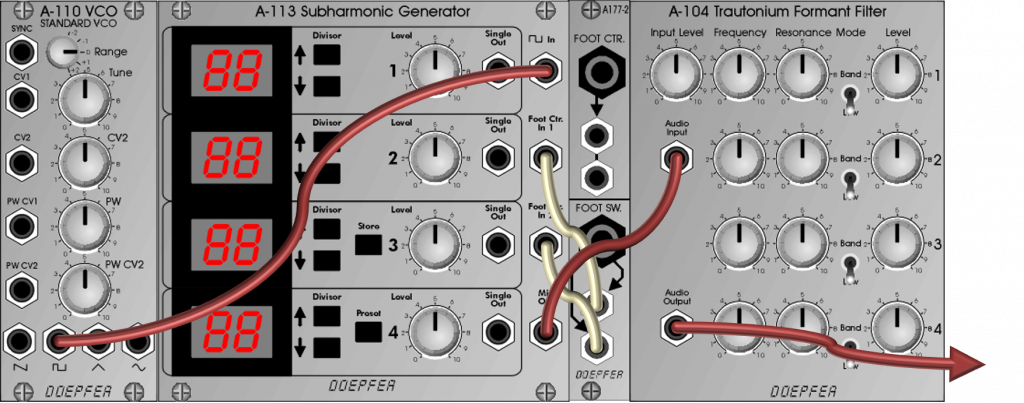
A slightly different sawtooth
The A-113 Subharmonic Generator does not generate “pure” sawtooth signals, but oscillations with rounded edges. In addition, the subharmonic generator also generates different “sawtooth-like” oscillations from different pulsewidths (the input signal is shown below):
Divider for trigger signals
The module is ideal for generating complex trigger patterns and can also process the low frequencies of clock signals well. The generated sawtooth signals “work” well as trigger signals. You can then change the trigger pattern during a performance “for live use”, there are storage options, different patterns can be called up via foot switch / gate signals, and last but not least the four displays are an excellent guide for “polyrhythmic derailments”.
Additional 5V power supply
The first version of the module (recognizable by the 16-pin bus cable) requires a power supply of 50 mA at +5 V in addition to the usual +12 V. From the new PSU3 power supply unit onwards, this supply voltage is provided by default via the bus. Older power supplies require the 5V Low Cost Adapter, for example, which is plugged into a free slot on the same bus as the module and which then provides the +5V.
The A-113 produced from spring 2015 does not require an additional 5V power supply.
Caution: Never use the 5V adapter with a new PSU3 power supply! (Risk of damaging the power supply or adapter.)
Sound examples
-
A-104, A-113, A-198 / Mini Trautonium
Setup: An A-110-1 VCO is controlled by an A-198 Ribbon Controller. The control voltage is quantized with an A-156, but is then smoothed with an A-171-2 VC Slew Generator according to the pressure on the controller (portamento).
The square output of the A-110-1 controls an A-113 subharmonic generator, the predefined presets are controlled by two tracks from an A-157 trigger sequencer. The mix of the triangle output of the A-110-1 and the A-113 is processed with an A-104 Trautonium filter, the filter frequencies are controlled manually.
Finally, the output of the filter is amplified with an A-131 VCA, which is controlled by both the A-198‘s pressure and the envelope of an A-142-1 VC Decay. The A-142-1 is triggered by the A-198‘s pressure.
Plenty of delay and reverb from the DAW at the end.
Trautonium in modern A-100 Setup.
Technical specifications
| Width | 26 HP |
| Depth | 90 mm |
| Power requirements | 30 mA (+12V) / -10 mA (-12V) – old version 120 mA (+12V) / -10 mA (-12V) – new version |
| Additional power requirement | 100 mA (+5 V) – only the old version, no longer necessary with the new one from 2015 |
